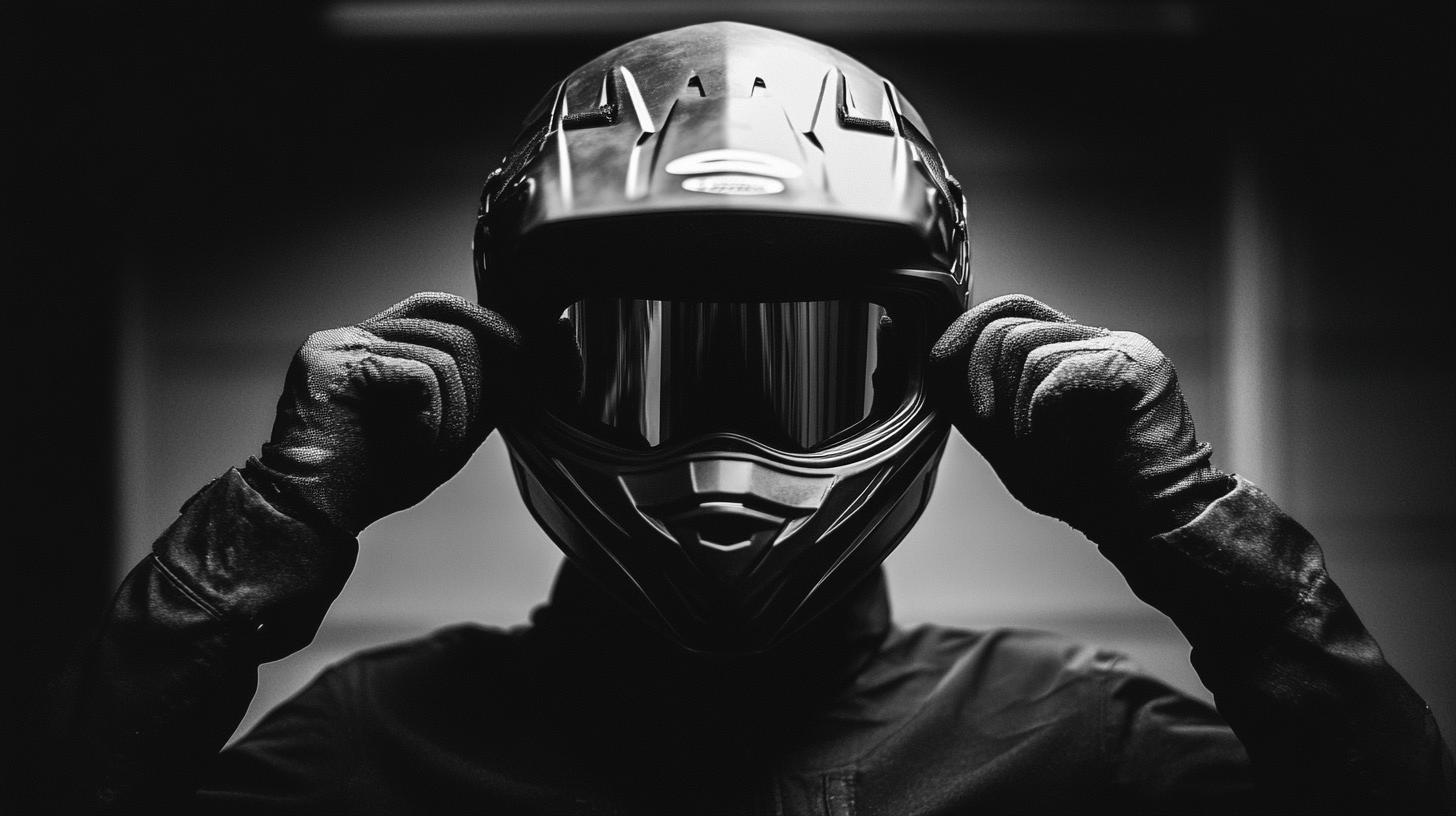Ever felt like wresting a bear while slipping on a motorcycle helmet, only to emerge with throbbing ears? Let's face it—many riders have been there.
Mastering the technique of donning a helmet without discomfort can transform rides from tolerable to truly enjoyable. Dive into the practical approaches of securing a snug headpiece while keeping ear pain at bay.
This guide is your road map to understanding how to put on a motorcycle helmet without hurting your ears. Get ready to ride with comfort and confidence every time you hit the road.
Step-by-Step Guide to Wearing a Motorcycle Helmet Without Ear Pain

Selecting the correct helmet size is crucial in preventing ear pain. Begin by measuring your head circumference accurately. This measurement will help you find a helmet that fits snugly without being overly tight.
Consult the manufacturer's sizing chart to match your measurement with the appropriate helmet size. A properly sized helmet ensures that there is enough room around the ears, reducing the risk of discomfort caused by pressure points.
The technique for putting on a helmet without causing ear pain involves careful handling and positioning. Start by pulling the straps apart to widen the opening of the helmet. This action helps create more space for your ears, minimizing the chance of them bending or getting pinched.
Tilt the helmet slightly forward when placing it on your head. This forward tilt allows the helmet to slide over your ears more smoothly. After positioning the helmet, gently roll it back into place, ensuring a comfortable fit without excessive pressure on the ears.
-
Measure head circumference accurately.
-
Consult the manufacturer's sizing chart.
-
Pull helmet straps wide apart.
-
Tilt the helmet forward when placing it on your head.
-
Gently roll the helmet back into position.
-
Adjust padding for comfort around the ears.
Helmets with adjustable or removable padding offer additional benefits for comfort. These features allow you to customize the fit around your ears, ensuring that the helmet sits comfortably without exerting undue pressure.
Adjustable padding can be repositioned or replaced to better accommodate your ear shape and size. By choosing a helmet with these options, riders can enhance their comfort level, making long rides more enjoyable and reducing the risk of ear pain.
Adjusting Helmet Fit for Maximum Comfort

Achieving a snug but comfortable helmet fit is crucial for both safety and preventing ear pain. Regular adjustment of the helmet straps is necessary to maintain this balance. How tight should helmet straps be? The straps should be tight enough to keep the helmet securely in place, yet not so tight that they cause discomfort.
This balance can be achieved by regularly checking the strap tension and adjusting them to avoid excessive pressure on the head and ears. A snug helmet fit ensures that the helmet remains stable while riding, preventing it from shifting, which can lead to discomfort and potential ear pain.
If the helmet feels too tight around the ears, there are options available to modify the fit. One way to adjust the fit is by using thinner cheek pads or ear pads. Why use thinner padding? Thinner padding can reduce pressure around the ear area, providing more space and comfort without compromising the helmet's overall fit.
Additionally, some helmets come with adjustable or removable interior components. These features allow riders to customize the fit according to their individual needs, ensuring that the helmet fits well without causing unnecessary pressure points around the ears. Adjusting these elements can significantly enhance comfort, especially on longer rides.
Choosing the Right Helmet Type and Size

Selecting the correct helmet size is the first step in preventing ear pain while riding. How do you ensure a helmet fits properly? Measure your head's circumference using a flexible tape measure, positioning it about an inch above your eyebrows and ears. This measurement provides a baseline for selecting a helmet that offers a snug fit without being excessively tight.
Referencing the manufacturer's sizing chart is crucial to match your measurement to the appropriate helmet size. A well-fitted helmet should sit comfortably on the head, providing enough clearance around the ears to avoid pressure points that lead to discomfort.
Different helmet types offer varying levels of comfort and ear protection. Among the options, which helmet types are best for minimizing ear discomfort? Open-face and modular helmets generally provide more room around the ear area, making them suitable choices for individuals with larger ears or those prone to ear pain.
While full-face helmets offer comprehensive protection, their snug fit may exert more pressure around the ears. In contrast, modular helmets provide the option to lift the chin bar, which can ease pressure and improve airflow, enhancing comfort during rides.
-
Accurate head measurement.
-
Helmet type (full-face, open-face, modular).
-
Softer interior linings.
-
Removable or adjustable padding.
-
Space around ear area.
Helmets with softer interior linings contribute significantly to reducing pressure points that cause ear pain. Why choose helmets with softer linings? These materials offer a cushion-like effect, distributing pressure more evenly across the head and minimizing discomfort around sensitive areas such as the ears.
Additionally, helmets featuring removable or adjustable padding allow riders to customize the fit, accommodating different ear shapes and sizes. Open-face or modular designs not only provide extra space but also allow easier adjustments, making them ideal for those seeking a blend of comfort and functionality.
Accessories and Techniques for Preventing Ear Discomfort

Thin, breathable balaclavas or skull caps are effective in reducing ear friction while wearing a helmet. How can these accessories help? They provide a smooth layer between the helmet and skin, minimizing the chance of irritation caused by direct contact.
This layer of fabric helps distribute pressure more evenly and prevents ears from folding or getting pinched as the helmet is put on or removed. The breathable nature of these materials ensures that they do not trap heat, keeping the rider comfortable during long rides.
These accessories are particularly beneficial in providing a barrier that reduces potential chafing or pressure points, enhancing overall comfort.
Quick-release buckles are another feature aimed at easing helmet discomfort. What advantages do they offer? Quick-release systems simplify the process of taking the helmet on and off, reducing the need to tug on the straps, which can cause ear pain.
This mechanism allows for a smooth removal, eliminating the strain typically associated with traditional buckle systems. Additionally, helmets with features such as softer ear pads can further alleviate pressure, offering a more cushioned fit around sensitive areas.
These design elements work together to create a more pleasant riding experience, particularly for those who frequently put on and remove their helmets.
-
Breathable balaclavas.
-
Skull caps.
-
Quick-release helmets.
- Softer ear pads.
Essential Tips for Long Rides Without Ear Pain

Managing helmet comfort on long rides involves strategic breaks to alleviate pressure. How do breaks help reduce ear pain? Taking regular breaks allows for the redistribution of pressure exerted by the helmet on the ears and head. This simple action can prevent the buildup of discomfort that arises from prolonged wear.
During breaks, riders can remove their helmets to relieve pressure points and give their ears a chance to recover. Additionally, stretching and moving around during these intervals can enhance circulation and overall comfort, making the ride more enjoyable and less taxing on sensitive areas.
Correctly positioning earbuds or intercom systems is crucial in avoiding unnecessary ear pressure. How can improper positioning affect comfort? Earbuds or intercom devices that are not properly placed can press against the ears, causing discomfort and potential pain over time. Ensuring these devices sit comfortably and securely can prevent them from adding pressure under the helmet.
Adjusting their position before starting the ride can significantly contribute to a pain-free experience. Riders should verify that the devices are not causing any pressure or irritation, which could detract from the enjoyment and safety of their journey.
-
Regular breaks to relieve pressure.
-
Correct positioning of earbuds/intercoms.
-
Frequent adjustments for comfort.
Final Words
Choosing the correct size and employing a proper helmet technique significantly reduce ear discomfort. By focusing on how to put on a motorcycle helmet without hurting your ears, riders can enhance their comfort and confidence.
Ensuring a snug fit and selecting suitable helmet types are essential steps. Regular adjustments and accessories further aid in minimizing discomfort. With these strategies, each ride can be a safer and more enjoyable experience.
FAQ
Motorcycle helmet hurts ears when taking off
A: A motorcycle helmet hurting ears when taking off means it may be too tight or improperly adjusted. Consider adjusting padding or trying a helmet with adjustable features for comfort.
Best how to put on a motorcycle helmet without hurting your ears
A: It's best to put on a motorcycle helmet by pulling straps wide, tilting it forward, and gently rolling it back to minimize ear contact.
Helmet Liner
A: A helmet liner can provide an extra layer of comfort, reducing pressure and friction around the ears. It can help achieve a better fit and alleviate ear discomfort.
Motorcycle helmet cauliflower ear
A: Motorcycle helmet cauliflower ear is a condition that can develop from constant ear pressure and friction. Opt for helmets with comfortable padding and proper fit to prevent this issue.
Football helmet hurts ears
A: A football helmet hurting ears could indicate an improper fit. Adjusting padding or choosing a different size may alleviate discomfort.
Ear pain while wearing helmet
A: Ear pain while wearing a helmet may be resolved by ensuring a proper fit, adjusting straps, or selecting helmets with softer padding.
Motorcycle helmets
A: Motorcycle helmets protect riders by providing critical safety features such as impact resistance and face protection. Selecting the right helmet type and fit is crucial for comfort and safety.
What is the 2 2 2 rule when fitting a helmet on your head?
A: The 2 2 2 rule refers to the helmet fitting process: two fingers above the eyebrows, two fingers from the chin to the helmet strap, and two fingers inserted into the ear area for space.
Is it better for a motorcycle helmet to be tight or loose?
A: A motorcycle helmet should be snug but not too tight. It should fit securely without causing pressure points, allowing for comfort and safety.
Can you hear while wearing a motorcycle helmet?
A: Wearing a motorcycle helmet usually allows for hearing, but it may slightly muffle ambient sounds. Using helmets with built-in communication systems can enhance audio clarity.
Should a helmet hurt to put on?
A: A helmet should not hurt to put on. It may need adjustment or resizing if it causes discomfort during fitting. Proper fit is vital for comfort and safety.

Ryan Thompson is a 35-year-old sport bike enthusiast known for his adventurous spirit. With years of weekend rides and exploring new roads, Ryan brings fresh insights and firsthand experience to ProtectiveGearz. His energetic approach and passion for the latest gear make him a trusted source for riders seeking up-to-date advice.



